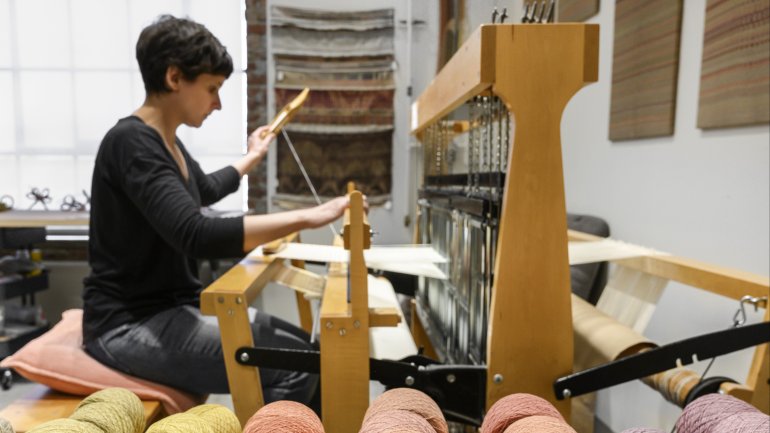The Queue: Tali Weinberg
Get to know the people featured in the pages of our magazine as they share what's inspiring them right now.
Tali Weinberg depicts the climate crisis by weaving together data and fiber.
Tali Weinberg probes the connections between human life and ecological crises in her poignant textile works. For the past eight years, Weinberg has incorporated data, organic fibers colored with plant- and insect-derived dyes, and plastic materials such as fishing line and medical tubes into landscape-based weavings showing the effects of climate change. In a recent work, Memories of Future Fires, she depicts the silhouette of a charred tree, evoking the human heart and lungs. In Silt Studies, a 2021 series of 18 woven tapestries, she uses temperature data from major American waterways to show incremental climate increases that threaten the natural world. Prior to her work with climate data, Weinberg used data around other social justice issues, such as gendered violence and housing insecurity, to make her textiles.
“I’ve loved craft for as long as I can remember, but I fell in love with weaving in particular when I realized how much of the world it contained,” she says. Paola Singer wrote about Weinberg and fellow data-driven craft artists Norwood Viviano and Adrien Segal in “Seeing Is Believing” in the Fall 2023 issue of American Craft.
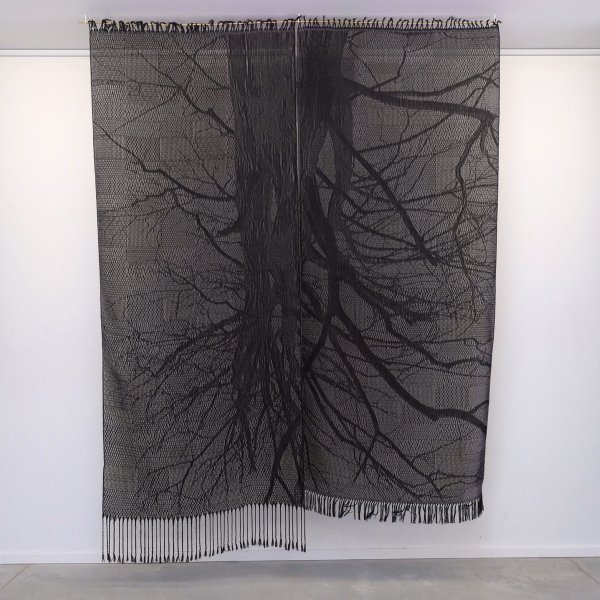
Tali Weinberg, Lungs, 2022, plant fibers, petrochemical-derived dyes and monofilament handwoven on a TC2 digital jacquard loom, 112 x 86 in., installed at Dreamsong Gallery in Minneapolis as part of the project Memories of Future Fires. Photo by Rebecca Heidenberg.
How do you describe your work or practice in 50 words or less?
I use textile processes like weaving and coiling to transform data, plant fibers and dyes, and plastics into abstract landscapes that explore relationships to place in the context of climate crisis. My current focus is the interdependence of ecological and human health, particularly the parallel harms fossil fuel extraction inflicts on the earth and our bodies.
How did you come to use data in your work?
My use of data grew from my interest in textiles as language and embodied knowledge. In my earlier work, I materialized text in series addressing labor and gender violence, and my first materializations of numerical data were in response to the housing crisis. I used the data similarly to how I used text: as a scaffold or entry point in the work. Data is valuable in condensing vast amounts of labor, time, and knowledge into a quickly digestible form, but it isn’t as objective as we’re taught, and it has as much potential to conceal as to reveal. I turned to the materiality and metaphors embodied in textiles as a counterweight to data’s limitations, to add the deeply personal and sociopolitical dimensions of the housing crisis—and, later, the climate crisis—back into the story the data tells.
What are your favorite tools in your tool kit, and how do you use them?
Right now, I’m excited by how the TC2 digital jacquard loom allows me to build narrative from relationships between woven structures, materials, data, and images. My most reliable go-to tools, though, are my hands and my books. I learn from, make with, and think with both.
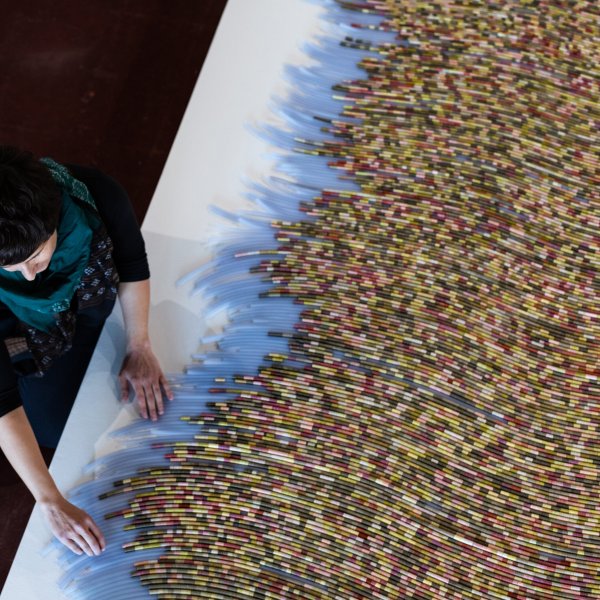
Weinberg installing her ever-changing sculpture Bound (i.5), 2019, annual average temperature data for 300 places, petroleum-derived medical tubing, plant fibers, plant and insect dyes, 72 x 120 x 1.5 in. Photo by Destiny Green.
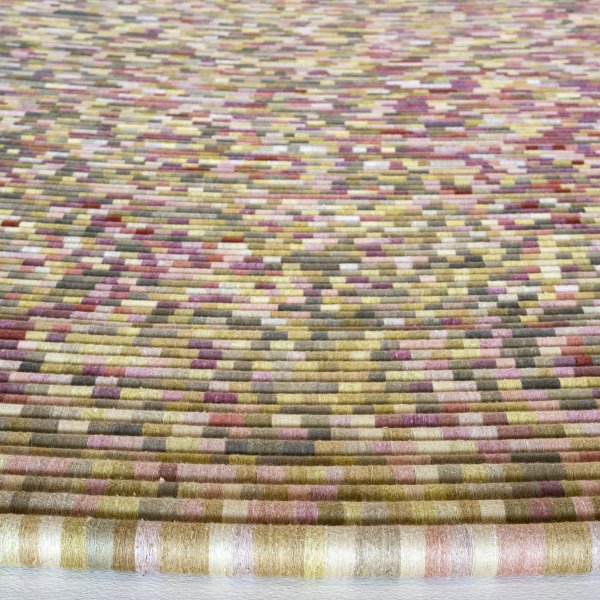
Detail of Bound (i.5). Photo by Philip Maisel.
Tell us about the first piece of textile art that captivated you. What about it drew you in?
Ann Hamilton’s indigo blue jumps to mind. It’s an installation/performance that considers the material implications of erasure and the inadequacy of accounting for somatic experiences through statistics and lists of facts. Hamilton points to textiles as both texts and intimate objects with social-material histories linking slavery to blue-collar labor.
If you could have work from any contemporary textile artist for your home or studio, whose would it be and why?
The most meaningful artworks in my home are from friends and mentors, like a paper weaving by Nathalie Miebach that she made from weather data for a specific place and grief-filled time I had told her about.
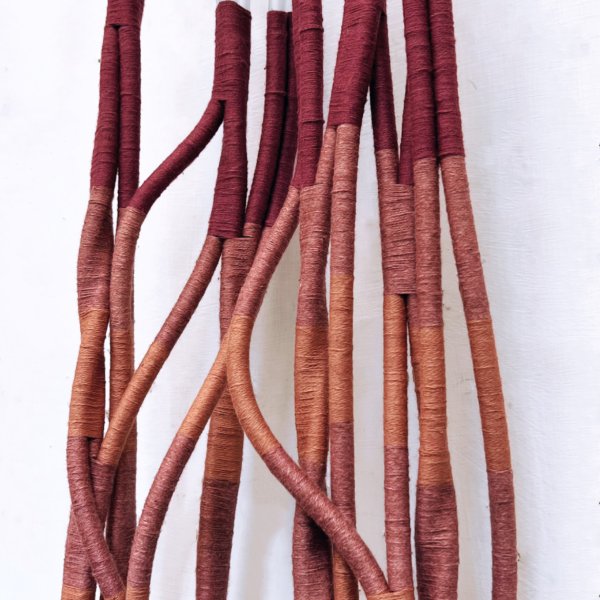
Unfinished, untitled new work that will eventually become a body-sized sculpture made from petrochemical-derived medical tubing wrapped with color-coded watershed climate data. Photo courtesy of the artist.
Which climate-related craft artists, exhibitions, or projects do you think the world should know about, and why?
I’m drawn to projects that point to intersections between ecological crises and other forms of injustice, that use material to help us see possibility and agency amidst the horrors of the climate crisis, and that open space for conversation with those who hold diverse perspectives. Consuelo Jimenez Underwood’s Borderlines series connecting how immigration policy harms people and the more-than-human world, Jean Shin’s Freshwater, and Cannupa Hanska Luger’s Mirror Shield Project with water protectors are a few that come to mind. Plus, Kirsty Robertson’s essay on textiles and oil and excerpts of Donna Haraway’s book Staying with the Trouble on the Crochet Coral Reef project and Navajo weaving.
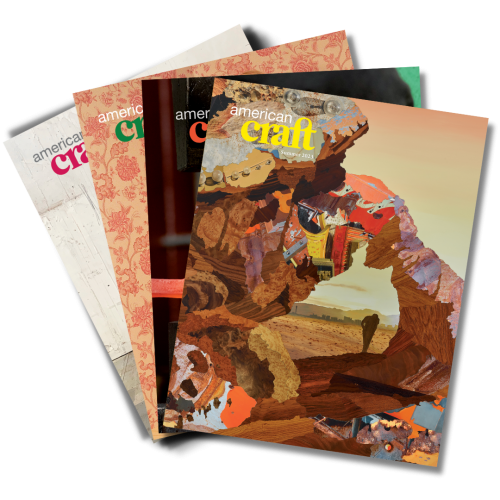
Learn more about the artists you love by becoming a member today!
Become a member to get a subscription to American Craft magazine and experience the work of artists who are defining the craft movement today.
